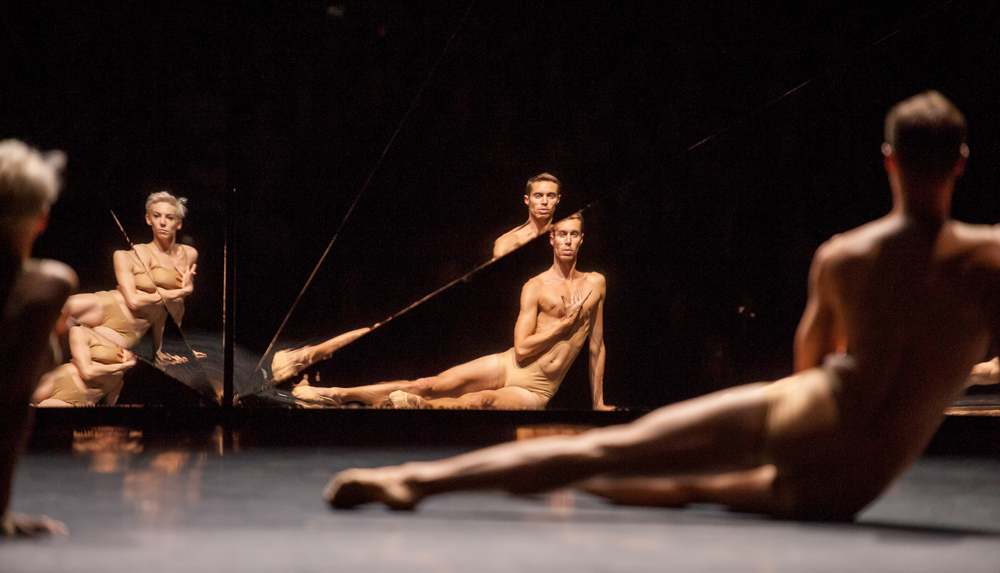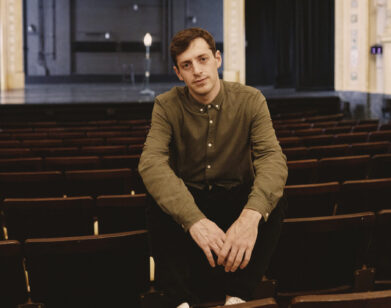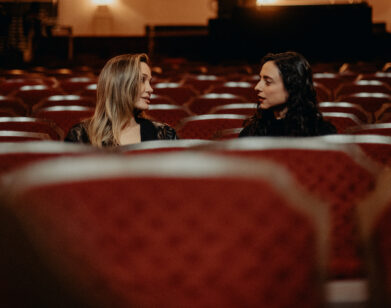A Branch Grows on a Tree of Codes
PHOTOS COURTESY OF STEPHANIE BERGER
The rarefied air often surrounding the notion of “an evening at the ballet” won’t be found at the Park Avenue Armory’s production of the collaborative, cross-disciplinary performance Tree of Codes. Upon arrival at the innovative ballet—which is scored by English composer and musician Jamie xx (of The xx), visualized by Copenhagen and Berlin-based artist Olafur Eliasson, and choreographed by Laurence Olivier Award winner Wayne McGregor—one encounters the back of the stage, lights, wires, scaffolding, and all. Seeing the set in its entirety doesn’t amount to knowing what comes next, though, which is total darkness, save for a constellation of limbs: bodies partially illuminated by white points of light, as they morph, disappear, pause, and join together, set to what sounds like a futuristic forest.
Following this opening, dancers from the Paris Opera Ballet Company and Company Wayne McGregor move in a serpentine and grounded manner, mimicking Jamie xx’s dreamy, experimental score. Through Eliasson’s projections and reflective layers, dancers are sharply reflected in a vibrant house of mirrors, allowing their bodies to extend infinitely into the distance. Unlike a typical performance, the audience is also reflected back at performers, sometimes even underneath the glow of a spotlight. You can, quite literally, see yourself in this ballet.
Eliasson and McGregor first came together through American author Jonathan Safran Foer’s sculptural art object/book Tree of Codes, which was originally inspired by The Street of Crocodiles (1934), a collection of short stories and one of few surviving works by 20th century Polish author Bruno Schulz. In Tree of Codes, Safran Foer dissects Schulz’s work, physically carving into the narrative to forge his own, resulting in an experimental book full of holes cutout where Schulz’s words once were. Now, Eliasson, McGregor, and Jamie xx have taken the same task upon themselves, using Safran Foer’s project as their base.
After debuting at England’s Manchester International Festival in July, Tree of Codes arrived in New York on Monday evening at the Park Avenue Armory for its U.S. premiere. The week before it took the stage, we sat down with McGregor and Eliasson (who is known for ambitious installations, like bringing the sun and clouds into a gallery at the Tate Modern and continuously dying many rivers green) to discuss their ballet.
HALEY WEISS: How have rehearsals been? Are you excited to see the ballet in a new space?
WAYNE MCGREGOR: Yeah, it’s quite an incredible space, right? We were a bit nervous to see how it would translate because it’s really hard to imagine unless you’ve stood in the space, with the bits there, how it can populate that kind of area of that scale. This process, up until next week, is that process of discovery; we’re discovering the space and discovering what we can do with the thing that we’ve made, translating it into here.
WEISS: Have you had to change the set or choreography to fit the stage differently?
OLAFUR ELIASSON: I think every venue has a local signature and it’s own type of generosity. In this case, the room of course is incredibly large, and it’s very generous, and this is very exciting. It just allows more space in general. Some of the older theaters, which are also amazing in a way, they are much more compact. So the great luxury here is to simply allow people to see the theater from the outside as they walk through the stage, going through the entrance, to sitting down.
We are literally allowing the people to enter the piece by walking through from backstage up to the front. I think that is great. I wouldn’t say it’s demystifying because you don’t really know what you’re looking at, but it is a quite generous aspect that you’re suddenly introduced to the machinery up front. In the classic theater stage situation you enter and the stage is the last thing you see when you sit down. Then of course you have no access. That’s the whole idea about it; you have no access to the machinery. That’s why the Armory is so amazing; there are no secrets. Everything is revealed, the people are not kept in the illusion that it’s magic because we are not in Las Vegas, this is not Siegfried and Roy.
MCGREGOR: Oh no, I like Siegfried and Roy! [all laugh]
WEISS: Going back to the beginning of this collaboration, how and when did it come about? When did you first encounter Tree of Codes, this lovely book and sculptural work of art?
MCGREGOR: Have you had that book a long time?
WEISS: I got it when it first came out, but it took me months to actually receive it. It was such a satisfying feeling when I finally got it in the mail.
MCGREGOR: That’s exactly my experience, too. I had it and read it, and kept returning to it. It was something that I was really intrigued by. Olafur was talking about that idea of the theater always being inside out—the bones of the theater being exposed and the experience of people walking through it. I think, in a way, the beautiful thing Jonathan [Safran Foer] does in that novel is that it’s like the exoskeleton of a book. You get a different kind of skeletal structure to reading, which I really love. I like the idea of redaction, of taking things away to produce something else. I like the idea of holes that you can fill with your own imagination and dreams. I thought immediately that I could convert that into some kind of choreographic language but I knew it wasn’t right to do a theatrical version. That would be kind of pointless, because the whole thing is about spaces, and apertures, and not knowing, as much as it is about knowing. And it was a dream for me to work with Olafur; if I was going to choose anyone to work with, that’s what I wanted to do.
ELIASSON: I have a similar story, so to not repeat it: I had spoken to Jonathan for a while about the book as an object and the potential of the analog, sculptural quality of a book—not just the object itself, but the quality of reading it and this ephemeral relationship you can develop with the narrative, and how it feels in your hand, the gravity of it, versus the digital book, which I’m not against, but I want to explore that people maybe underestimate the fact that there is quite a difference [in] reading a book on a Kindle.
So when Jonathan presented this idea I thought it was incredibly exciting. Just the principle of carving out a narrative by the removal of words was a very interesting one, and spatially I’ve been curious about similar approaches. Of course, the most famous ones are the Lalibela churches in Ethiopia, which were built by removal of rock rather than adding rock. So I knew Wayne’s work, and I knew Alex [Poots, the Armory’s Artistic Director] because I had worked with him. Alex put us together.
Wayne and Alex had seen [Jonathan’s] book and I knew this book, so it was just perfect. We started talking about the sound being something that both had to be both very abstract but also be able to embrace a much broader context, almost popular music. This very rare combination of something very intelligent but experimental with a very wide reach is exactly what Jamie xx and The xx in general has been successful in. That’s how we all got together.
WEISS: Has it been interesting to watch each other’s processes because you work in different mediums?
MCGREGOR: I would probably not say watch process, but experience process. What’s been fascinating for me with Olafur and Jamie is what I thought I knew about what they did. Thinking you know the artists through their work, but then actually understanding their process is a very different kind of thing. The way in which decisions are made, the journey of what’s lost and found in a piece, is very different from perhaps how you might have predicted it. The joy of collaborating, I think, means being lost and not knowing what you’re supposed to be doing. So in a way, that’s where the learning is.
We were talking earlier about how it’s indistinguishable which art form is the lead [in the ballet]. Conventionally, in a dance performance, it’s prioritized as a hierarchy of performance. It’s usually, but not always, the dance being a descriptor of music in some way and all of the other elements are subsidiary to that and help an audience understand the primacy of the dance language itself. Some people still find that quite difficult, to come see this performance and not do that; they can’t help but articulate it in terms of a hierarchy of things of watching. The challenge is not to do that, if you can, because that’s what we’ve really tried to do. Olafur had physical ideas in the same way that Jamie had spatial ideas; it’s much more ambiguous, what those lines and connections are. And something Olafur might have said to me early on has affected what I make with the body, even though he was talking about something he was thinking about making in terms of the scenic elements. That’s where I think the pleasure has been, not in watching as an objective thing you see from a distance and go, “How did that play out?”
WEISS: I’m curious as to how much of the book literally translates into the ballet. Even though Tree of Codes is poetic and surreal, there’s a narrative, and there are characters. Do you think there is a narrative to the ballet in a similar way, or is it more of an abstract interpretation?
ELIASSON: It’s more abstract and it’s also more structured. It’s more about whether there is an unfolding of narrative in the narrative, in the narrative, in the narrative. So there are a lot of stages in the play where there is a story inside of a story, inside of a story, which I think, in this case, is in the mirrors and the reflections. [Bruno] Schulz’s book in particular is very flowery and dreamy, and I wouldn’t say voluptuous, but that has inspired [the ballet] a lot, and there are these cuts into that, which are very structured. So there’s a contrast between the dreamy quality of the narrative and the very razor sharp cuts.
So actually, there are a lot of relationships [with the book], but the truth is, I don’t think you can see them. [laughs] The book as a book is a work of art in and of itself, and so is the play. In that sense it was not meant to be representational of the book, but more to see if the book could create another outset. Of course, I also think Jonathan is a brilliant author who does what he does with such generosity that it is very rewarding to work with that. I know Wayne worked specifically with the book, what the story is, and how to translate that into dance and movement. It was very inspiring for me to see the architectural quality of the book in the hand of, I would say, a movement specialist, rather than a dancer. The book has been there all along.
MCGREGOR: For me, it depends on what you call literal in relation to that book. If it were a score, if it was a piece of music, and you were looking at that in a literal dimension, that page is a literal dimension beyond the words; the text is not just what the words are, or what the words are saying. The text is also the relationship between [holding the book and moving pages to different points in the air].
In a way, if you think about this as a living score, you can use it in ways to pull dynamic, form, and idea, and build imaginative ways in which to populate it. I played the whole book; I choreographed every single page. We didn’t use it all, and was it important that you saw what my solution was to that page? No. But the fact is, without the page, I would have never had made the decisions that I made. So the book is in the process of the thing that was made.
What was interesting to me was to do a factual approach to the page, have a bank of stuff, and then decide, “Where’s the richness in this?” For me, that’s a similar process of redaction to [Safran Foer] going, “Okay, in this volume of stuff that I now have, in this new physical score, where are the opportunities for me to exploit? How do I pull out this and that?” That’s why it was very analogous to the process of Jonathan writing this.
WEISS: On my way up here, through a doorway I saw what seemed to be a moving mirror. It was surprising because when I saw it, I thought it was just a wall, and then it moved slightly and I realized it was a mirror. I’m curious as to how that will appear on stage. Can you see yourself as an audience member?
ELIASSON: Several times the audience is on stage so to speak, visually by using mirrors. The whole idea is that the audience is not here to consume a piece; they are, without necessarily doing much, being asked to immerse themselves in a more productive manner. This is how I work with my art, most of the time. In a way, you are seeing something but you’re also hungering the means through which you are seeing it, and wondering what you’re seeing but also how, and maybe more importantly, why? In that sense, the mirrors are part of a bigger thing where the dancers are the main protagonists.
The mirrors also add to this idea of several temporalities; are you seeing something with a delay, or is it in the front? Sometimes you almost have the feeling that there are these time lapses, like [Edweard] Muybridge or [Étienne-Jules] Marey’s photos, where you have a sequence of times. But here it’s done in a slightly different way because here we can’t actually stretch time. The mirrors are used to create these multiple reflections, as you’ll see, and the idea behind that is suggesting that temporality is relative; we can actually stretch and bend it. With the body we can slow down or speed up time. So you are, as the audience, being asked to consider—and this I say with a kind of metaphorical touch—what is “the now”? You’re seeing something that is about to happen, and something that has just happened. I think in dance and music that’s a very fundamental component.
TREE OF CODES RUNS THROUGH SEPTEMBER 21 AT THE PARK AVENUE ARMORY IN NEW YORK AND WILL TRAVEL TO MIAMI’S FAENA FORUM LATER THIS YEAR.







